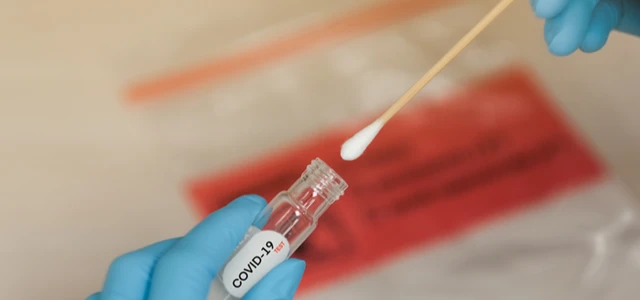You'll receive the latest updates on new standards, guidelines, and educational resources, as well as expert insights to help enhance your laboratory's performance and compliance.
COVID-19 Testing Information and Resources for Laboratories
Written By Sherry A. Dunbar, PhD, MBA, Senior Director, Global Scientific Affairs, Luminex Corporation and Shubhagata Das, Scientific Affairs Manager, Luminex Corporation
As of April 8, 2020, the global health threat now known as coronavirus disease-2019 (COVID-19) had infected more than 1.3 million people in over 200 countries and caused more than 79,000 deaths1. According to the “Operational Planning Guidelines to Support Country Preparedness and Response” developed by the World Health Organization (WHO), a coordinated global response plan that primarily involves prevention of human-to-human transmission of the virus, caring and monitoring of infected patients, and rapid diagnosis of the disease followed by effective infection control measures is required to control the COVID-19 pandemic2.

Written By Sherry A. Dunbar, PhD, MBA, Senior Director, Global Scientific Affairs, Luminex Corporation and Shubhagata Das, Scientific Affairs Manager, Luminex Corporation
As of April 8, 2020, the global health threat now known as coronavirus disease-2019 (COVID-19) had infected more than 1.3 million people in over 200 countries and caused more than 79,000 deaths1. According to the “Operational Planning Guidelines to Support Country Preparedness and Response” developed by the World Health Organization (WHO), a coordinated global response plan that primarily involves prevention of human-to-human transmission of the virus, caring and monitoring of infected patients, and rapid diagnosis of the disease followed by effective infection control measures is required to control the COVID-19 pandemic2.
Within weeks of the first identified cases of the SARS-CoV-2, the viral genome was sequenced and released publicly for immediate public health support3-7. Since then, several diagnostic assays have been developed, both in-house and commercial, for the rapid detection and identification of this novel coronavirus pathogen. However, as the number of confirmed infections continued to rise, global demand for testing expanded well beyond existing reagent production capacity. Medical and laboratory professionals and manufacturers around the world voiced concerns about the impact of existing regulations on the use of diagnostic tests by medical laboratories during the COVID-19 outbreak8. Regulatory agencies, such as the FDA in the United States, responded quickly with revised Emergency Use Authorization (EUA) regulations and requirements to expand testing for SARS-CoV-2, allow medical laboratories to use their local laboratory developed tests (LDTs) before FDA clearance, and allow companies to rapidly receive regulatory approval upon appropriate clinical validation and submission of data9,10.
As of April 7, 2020, 30 molecular assays for SARS-CoV-2 testing have received FDA EUA in the United States and are commercially available for diagnostic testing (In vitro Diagnostics EUAs). Similarly, several in-house and commercial molecular tests and immunoassays have been developed globally and have been approved by other regulatory agencies. They are currently being validated by several laboratories (SARS-CoV-2 Diagnostic assays).
As medical laboratories are working to bring testing for COVID-19 in-house, as well as organizing their respective laboratories to meet needs for additional safety measures, laboratory standards and guidelines can be critical resources for advice and guidance to help them navigate this global crisis. The Clinical and Laboratory Standards Institute (CLSI) has compiled a list of relevant guidelines and standards that can help our healthcare colleagues who are in the process of bringing on COVID-19 testing or modifying their laboratory processes to accommodate the high demand for testing. Additionally, guidance documents and assessment tools released by the World Health Organization (WHO) can be particularly useful to laboratories that are currently involved in COVID-19 testing11-13.
View CLSI Documents Helpful for COVID-19 Testing
References:
- World Health Organization. Coronavirus disease 2019 (COVID-19) Situation Report – 79. 2020 [cited April 8, 2020; Available from: https://www.who.int/docs/default-source/coronaviruse/situation-reports/20200408-sitrep-79-covid-19.pdf?sfvrsn=4796b143_4.]
- World Health Organization. COVID-19: Operational Planning Guidelines and COVID-19 Partners Platform to support country preparedness and response. 2020 [cited March 5, 2020; Available from: https://www.who.int/docs/default-source/coronaviruse/covid-19-sprp-unct-guidelines.pdf.]
- Sah, R., et al., Complete Genome Sequence of a 2019 Novel Coronavirus (SARS-CoV-2) Strain Isolated in Nepal. Microbiology Resource Announcements, 2020. 9(11).
- Yu, H., et al., Genomic analysis of a 2019-nCoV strain in the first COVID-19 patient found in Hangzhou, Zhejiang, China. Zhonghua yu fang yi xue za zhi [Chinese journal of preventive medicine], 2020. 54: p. E026.
- Kim, J.-M., et al., Identification of Coronavirus Isolated from a Patient in Korea with COVID-19. Osong public health and research perspectives, 2020. 11(1): p. 3-7.
- Wu, F., et al., A new coronavirus associated with human respiratory disease in China. Nature, 2020. 579(7798): p. 265-269.
- Zhu, N., et al., A novel coronavirus from patients with pneumonia in China, 2019. New England Journal of Medicine, 2020.
- American Society for Microbiology. Amid COVID-19, ASM Voices Concerns about Clinical Access to Tests. 2020 [cited April 6, 2020; Available from: https://asm.org/Articles/Policy/2020/Amid-COVID-19,-ASM-Advocates-for-Changes-to-FDA-Em.
- U.S. Food & Drug Administration. Coronavirus (COVID-19) Update: FDA Issues New Policy to Help Expedite Availability of Diagnostics. 2020 [cited April 6, 2020; Available from: https://www.fda.gov/news-events/press-announcements/coronavirus-covid-19-update-fda-issues-new-policy-help-expedite-availability-diagnostics.]
- McGinley Laurie , Johnson Carolyn Y., and W. William. New FDA policy will expand coronavirus testing. 2020 [cited April 6, 2020; Available from: https://www.washingtonpost.com/health/2020/02/29/new-fda-policy-will-expand-coronavirus-testing/.]
- World Health Organization. Laboratory testing for coronavirus disease 2019 (COVID-19) in suspected human cases: interim guidance, 2 March 2020. 2020 April 7,2020]; Available from: https://apps.who.int/iris/bitstream/handle/10665/331329/WHO-COVID-19-laboratory-2020.4-eng.pdf?sequence=1&isAllowed=y.]
- World Health Organization. Assessment tool for laboratories implementing COVID-19 virus testing: interim guidance, 8 April 2020. 2020 April 8, 2020]; Available from: https://apps.who.int/iris/bitstream/handle/10665/331714/WHO-2019-nCoV-Lab_Assessment_Tool-2020.1-eng.pdf?sequence=1&isAllowed=y.]
- World Health Organization. Advice on the use of point-of-care immunodiagnostic tests for COVID-19: scientific brief, 8 April 2020. 2020 [cited April 8, 2020; Available from: https://apps.who.int/iris/bitstream/handle/10665/331713/WHO-2019-nCoV-Sci_Brief-POC_immunodiagnostics-2020.1-eng.pdf?sequence=1&isAllowed=y.]